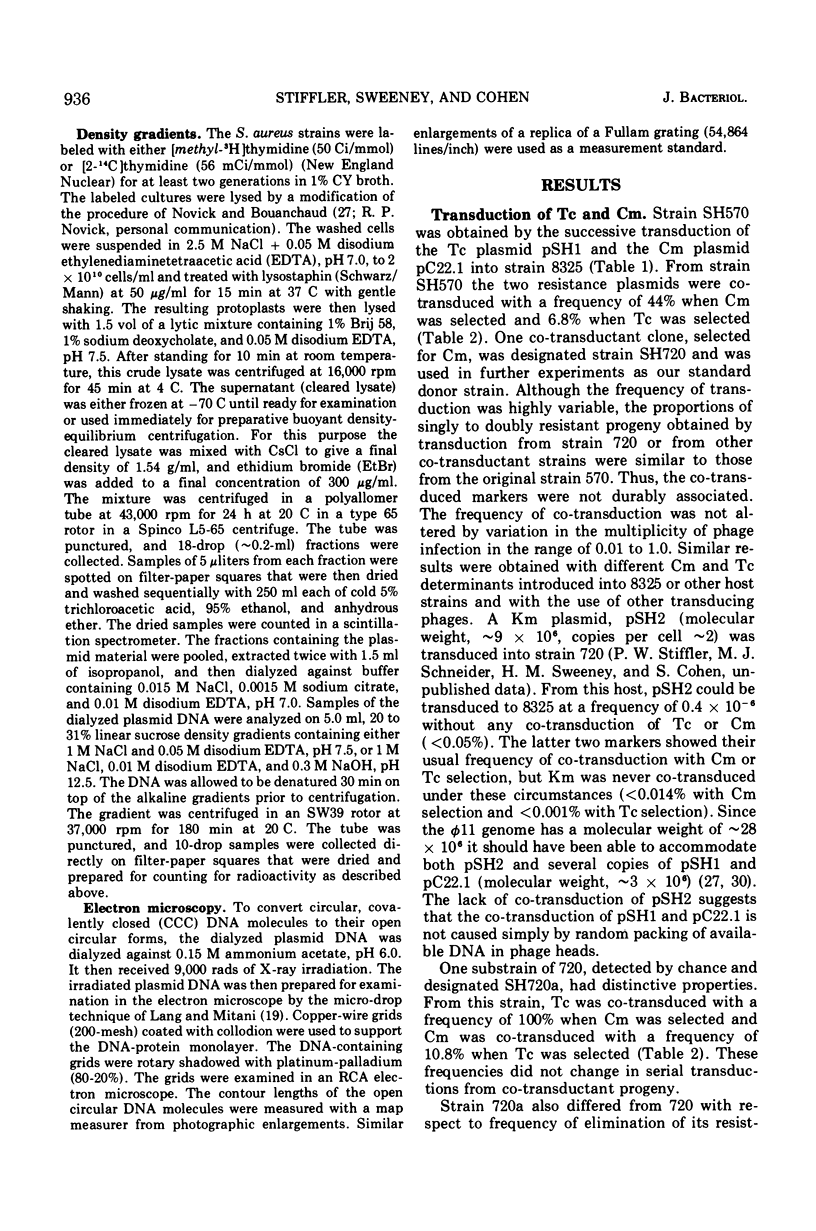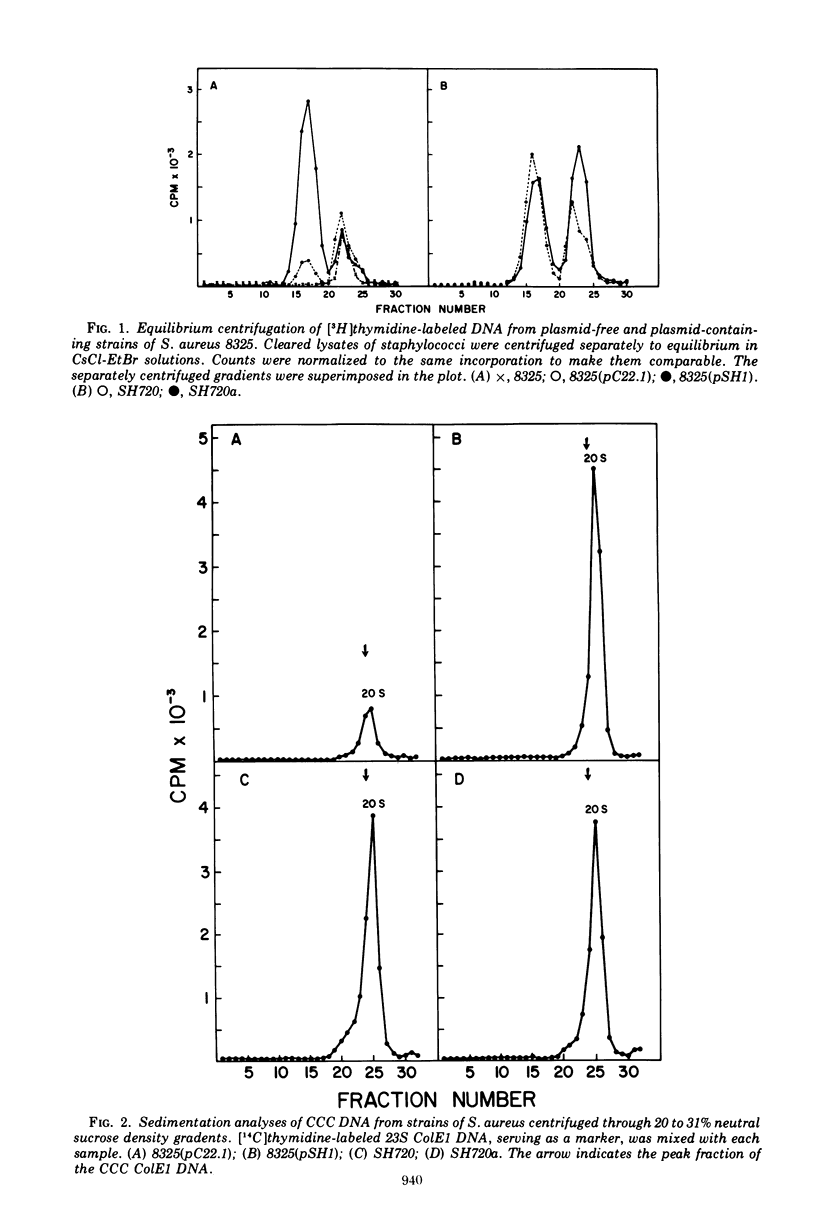Abstract
Independent plasmids mediating resistance either to tetracycline (Tc) or chloramphenicol (Cm) were transduced successively into Staphylococcus aureus strain 8325. From this doubly resistant donor strain, Tc was co-transduced with a frequency of 40 to 50% when Cm was selected. Co-transduction of Cm was 5 to 10% with Tc selection. Plasmid elimination was infrequent and restricted to the Cm plasmid. A variant, doubly resistant strain gave 100% co-transduction of Tc and Cm and a high rate of joint elimination of both plasmid markers. Co-transduction of the plasmids from recombination-deficient donor strains was much reduced if the plasmids had been introduced separately into the donor strain, but occurred at the normal high rate if they had been introduced jointly. The plasmids were co-transformed at relatively low rates with closed circular deoxyribonucleic acid (DNA) from doubly resistant donors, but not with DNA from a mixed lysate of singly resistant strains. Our evidence favored a hypothesis of recombination-dependent, reversible linkage between the two plasmids as the basis for their co-transduction. Examination of plasmid DNA from the doubly resistant strains by ultracentrifugal and electron microscopic methods did not disclose any physical differences between singly and doubly resistant strains that might account for the observed co-transduction.
Full text
PDF










Images in this article
Selected References
These references are in PubMed. This may not be the complete list of references from this article.
- BURGI E., HERSHEY A. D. Sedimentation rate as a measure of molecular weight of DNA. Biophys J. 1963 Jul;3:309–321. doi: 10.1016/s0006-3495(63)86823-x. [DOI] [PMC free article] [PubMed] [Google Scholar]
- Bazaral M., Helinski D. R. Circular DNA forms of colicinogenic factors E1, E2 and E3 from Escherichia coli. J Mol Biol. 1968 Sep 14;36(2):185–194. doi: 10.1016/0022-2836(68)90374-4. [DOI] [PubMed] [Google Scholar]
- Clowes R. C. Molecular structure of bacterial plasmids. Bacteriol Rev. 1972 Sep;36(3):361–405. doi: 10.1128/br.36.3.361-405.1972. [DOI] [PMC free article] [PubMed] [Google Scholar]
- Cohen S. N., Chang A. C., Hsu L. Nonchromosomal antibiotic resistance in bacteria: genetic transformation of Escherichia coli by R-factor DNA. Proc Natl Acad Sci U S A. 1972 Aug;69(8):2110–2114. doi: 10.1073/pnas.69.8.2110. [DOI] [PMC free article] [PubMed] [Google Scholar]
- Cohen S. N., Silver R. P., McCoubrey A. E. Isolation of catenated forms of R factor DNA from minicells. Nat New Biol. 1971 Jun 23;231(25):249–252. doi: 10.1038/newbio231249a0. [DOI] [PubMed] [Google Scholar]
- Cohen S., Sweeney H. M. Transduction of Methicillin Resistance in Staphylococcus aureus Dependent on an Unusual Specificity of the Recipient Strain. J Bacteriol. 1970 Dec;104(3):1158–1167. doi: 10.1128/jb.104.3.1158-1167.1970. [DOI] [PMC free article] [PubMed] [Google Scholar]
- Dubnau E., Stocker B. A. Behavior of three colicine factors and an R (drug resistance) factor in Hfr crosses in Salmonella typhimurium. Genet Res. 1967 Jun;9(3):283–297. doi: 10.1017/s0016672300010582. [DOI] [PubMed] [Google Scholar]
- Foster T. J., Howe T. G. Recombination and complementation between R factors in Escheichia coli K 12. Genet Res. 1971 Dec;18(3):287–297. doi: 10.1017/s0016672300012696. [DOI] [PubMed] [Google Scholar]
- Goering R. V., Pattee P. A. Mutants of Staphylococcus aureus with increased sensitivity to ultraviolet radiation. J Bacteriol. 1971 Apr;106(1):157–161. doi: 10.1128/jb.106.1.157-161.1971. [DOI] [PMC free article] [PubMed] [Google Scholar]
- Grubb W. B., O'Reilly R. J. Joint transduction of separate extrachromosomal drug resistance determinants in Staphylococcus aureus E169. Biochem Biophys Res Commun. 1971 Feb 5;42(3):377–383. doi: 10.1016/0006-291x(71)90381-0. [DOI] [PubMed] [Google Scholar]
- Grubb W. B., O'Reilly R. J., May J. W. Segregation o co-transduced streptomycin and tetracycline resistance in Staphylococcus aureus. Genet Res. 1972 Aug;20(1):43–50. doi: 10.1017/s0016672300013574. [DOI] [PubMed] [Google Scholar]
- Kasuga T., Hashimoto H., Mitsuhashi S. Drug resistance of staphylococci. VII. Genetic determinants responsible for the resistance to tetracycline, streptomycin, sulfanilamide, and penicillin. J Bacteriol. 1968 May;95(5):1764–1766. doi: 10.1128/jb.95.5.1764-1766.1968. [DOI] [PMC free article] [PubMed] [Google Scholar]
- Kingsbury D. T., Helinski D. R. Temperature-sensitive mutants for the replication of plasmids in Escherichia coli. I. Isolation and specificity of host and plasmid mutations. Genetics. 1973 May;74(1):17–31. doi: 10.1093/genetics/74.1.17. [DOI] [PMC free article] [PubMed] [Google Scholar]
- Kontomichalou P., Mitani M., Clowes R. C. Circular R-factor molecules controlling penicillinase synthesis, replicating in Escherichia coli under either relaxed or stringent control. J Bacteriol. 1970 Oct;104(1):34–44. doi: 10.1128/jb.104.1.34-44.1970. [DOI] [PMC free article] [PubMed] [Google Scholar]
- Kupersztoch Y. M., Helinski D. R. A catenated DNA molecule as an intermediate in the replication of the resistance transfer factor R6K in Escherichia coli. Biochem Biophys Res Commun. 1973 Oct 15;54(4):1451–1459. doi: 10.1016/0006-291x(73)91149-2. [DOI] [PubMed] [Google Scholar]
- Lacey R. W. Genetic basis, epidemiology, and future significance of antibiotic resistance in Staphylococcus aureus: a review. J Clin Pathol. 1973 Dec;26(12):899–913. doi: 10.1136/jcp.26.12.899. [DOI] [PMC free article] [PubMed] [Google Scholar]
- Lang D., Mitani M. Simplified quantitative electron microscopy of biopolymers. Biopolymers. 1970;9(3):373–379. doi: 10.1002/bip.1970.360090310. [DOI] [PubMed] [Google Scholar]
- Lindberg M., Novick R. P. Plasmid-specific transformation in Staphylococcus aureus. J Bacteriol. 1973 Jul;115(1):139–145. doi: 10.1128/jb.115.1.139-145.1973. [DOI] [PMC free article] [PubMed] [Google Scholar]
- MITSUHASHI S., HASHIMOTO H., KONO M., MORIMURA M. DRUG RESISTANCE OF STAPHYLOCOCCI. II. JOINT ELIMINATION AND JOINT TRANSDUCTION OF THE DETERMINANTS OF PENICILLINASE PRODUCTION AND RESISTANCE TO MACROLIDE ANTIBIOTICS. J Bacteriol. 1965 Apr;89:988–992. doi: 10.1128/jb.89.4.988-992.1965. [DOI] [PMC free article] [PubMed] [Google Scholar]
- MITSUHASHI S., OSHIMA H., KAWAHARADA U., HASHIMOTO H. DRUG RESISTANCE OF STAPHYLOCOCCI. I. TRANSDUCTION OF TETRACYCLINE RESISTANCE WITH PHAGE LYSATES OBTAINED FROM MULTIPLY RESISTANT STAPHYLOCOCCI. J Bacteriol. 1965 Apr;89:967–976. doi: 10.1128/jb.89.4.967-976.1965. [DOI] [PMC free article] [PubMed] [Google Scholar]
- Morrison T. G., Malamy M. H. Comparisons of F factors and R factors: existence of independent regulation groups in F factors. J Bacteriol. 1970 Jul;103(1):81–88. doi: 10.1128/jb.103.1.81-88.1970. [DOI] [PMC free article] [PubMed] [Google Scholar]
- NOVICK R. P. ANALYSIS BY TRANSDUCTION OF MUTATIONS AFFECTING PENICILLINASE FORMATION IN STAPHYLOCOCCUS AUREUS. J Gen Microbiol. 1963 Oct;33:121–136. doi: 10.1099/00221287-33-1-121. [DOI] [PubMed] [Google Scholar]
- Novick R. P., Bouanchaud D. The problems of drug-resistant pathogenic bacteria. Extrachromosomal nature of drug resistance in Staphylococcus aureus. Ann N Y Acad Sci. 1971 Jun 11;182:279–294. doi: 10.1111/j.1749-6632.1971.tb30664.x. [DOI] [PubMed] [Google Scholar]
- Novick R. P., Smith K., Sheehy R. J., Murphy E. A catenated intermediate in plasmid replication. Biochem Biophys Res Commun. 1973 Oct 15;54(4):1460–1469. doi: 10.1016/0006-291x(73)91150-9. [DOI] [PubMed] [Google Scholar]
- Novick R. Properties of a cryptic high-frequency transducing phage in Staphylococcus aureus. Virology. 1967 Sep;33(1):155–166. doi: 10.1016/0042-6822(67)90105-5. [DOI] [PubMed] [Google Scholar]
- Richmond M. H. Associated diploids involving penicillinase plasmids in Staphylococcus aureus. J Gen Microbiol. 1967 Jan;46(1):85–93. doi: 10.1099/00221287-46-1-85. [DOI] [PubMed] [Google Scholar]
- Rush M. G., Gordon C. N., Novick R. P., Warner R. C. Penicillinase plasmid DNA from Staphylococcus aureus. Proc Natl Acad Sci U S A. 1969 Aug;63(4):1304–1310. doi: 10.1073/pnas.63.4.1304. [DOI] [PMC free article] [PubMed] [Google Scholar]
- Shaw W. V., Brodsky R. F. Characterization of chloramphenicol acetyltransferase from chloramphenicol-resistant Staphylococcus aureus. J Bacteriol. 1968 Jan;95(1):28–36. doi: 10.1128/jb.95.1.28-36.1968. [DOI] [PMC free article] [PubMed] [Google Scholar]
- Sweeney H. M., Cohen S. Wild-type strain of Staphylococcus aureus containing two genetic linkage groups for penicillinase production. J Bacteriol. 1968 Oct;96(4):920–924. doi: 10.1128/jb.96.4.920-924.1968. [DOI] [PMC free article] [PubMed] [Google Scholar]
- Wyman L., Goering R. V., Novick R. P. Genetic control of chromosomal and plasmid recombination in Staphylococcus aureus. Genetics. 1974 Apr;76(4):681–702. doi: 10.1093/genetics/76.4.681. [DOI] [PMC free article] [PubMed] [Google Scholar]



